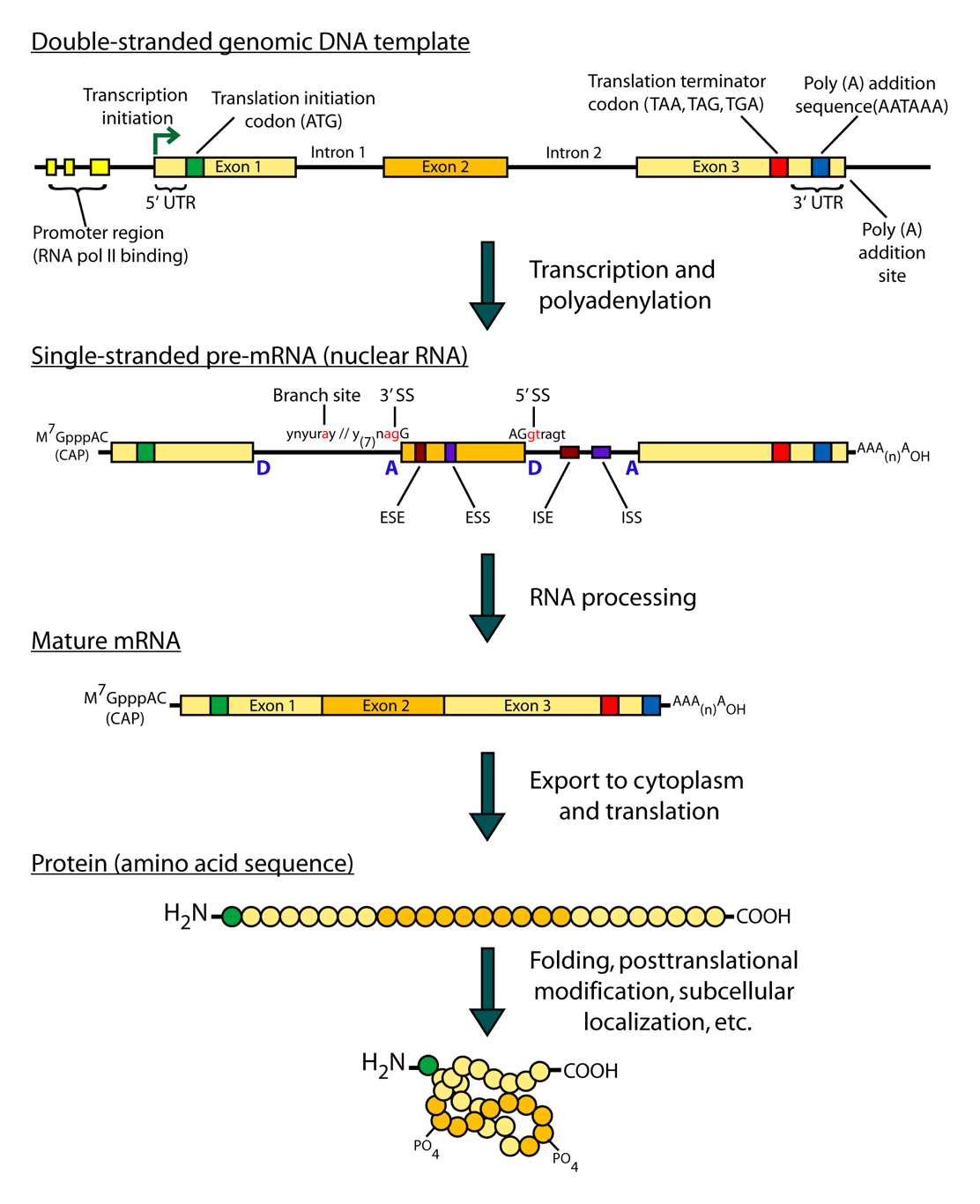From DNA to RNA to Proteins
Human body cells have a fairly complex workflow for functioning. Remember that all the cells in your body contain the exact same DNA sequence indside the nucleus. However, cells in your eyes behave differently from cells in your stomach, which also behave differently from cells in your skin. So, how could this happen?
It is important to know that the DNA inside the nucleus is not capable of taking actions that control the cell behavior. In other words, the DNA does not produce proteins on its own. The DNA is just a template that encodes instructions for all the human body cells on how to function (i.e. produce specific proteins). Those instructions are encoded in 1% only of the ~3 billion basepairs. The regions that encode for the-to-be-proteins are called genes.
DNA Transcription
Transcription is the process in which the DNA gets copied from the nucleus to the cytoplasm of the cell to produce RNA that is utlimately translated into a protein. But is the whole DNA transcriped (copied)? No. Only portions that represent genes are copied. Different genes get transcriped in different body cells. For example, your eye cells DNA has all genes, but only genes responsible for sight are transcriped. In your stomach cells, only genes that are responsible for digesting food are transcriped.
The question now is: how does the transcription process occur? The below picture shows the complete workflow. Let’s take it a step-by-step.
- A gene consists of exons and introns (more about them coming in a few lines).
- A gene start with a promoter region which marks the start position of the transcription.
- A gene ends with a Poly (A) sequence that marks the end position of the transcription. The Poly (A) region has the following sequence AATAAA followed by a long sequence of As.
- The sequence from promoter to the Poly (A) is transcribed to what we call pre-mature RNA. Why is it called pre-mature? becuase it still contains the introns.
- Then, a process called RNA Splicing gets rid of the introns and combines only the exons. This results in what is called mature RNA (or mRNA). Why is it called mature? yes, because it only includes only the exons that matter in the next step. In some contexts, we refer to the combination of pre-mature RNA and mature RNA as messenger RNA.
- The mRNA has Un-translated Region (UTR) in the beginning and end.
- The mRNA has a translation initiation codon (ATG) that marks where the translation into protein will start.
- The mRNA has a translation termination codon (TAA, TAG, TGA) that marks where the translation into protein will end.
- To translate RNA into Proteins, the mRNA gets out of the nucleus toward the cytoplasm and the translation starts from the initation codon toward the termination codon. This results in the Protein (amin acid sequence) which is the ultimate product of the transcription process.

FAQs
What are proteins?
Proteins are the ultimate product of a cell. They do the work of the cell. For example, when you eat, your stomach cells produce a special protein (through the transcription process) to digest food via chemcial reactions. Read more about proteins here
Why are genes encoded in only 1% of the whole DNA?
Most of the DNA does not encode for genes to preserve it from mutations. A mutation is a change in one or multiple basepairs (e.g. A -> C). If a mutation happens in a region that encode for a gene, it would cause problems in the cell function, and some time leads to diseases. Having 99% of the DNA not transcriped means that if a mutation occurs, there is only 1% probability that this mutation will cause a problem in your genes.
Why do genes have introns and UTRs?
The same reason as the previous question. If a mutation sadly occurs in the 1% of the gene region, this mutation might fall in the introns regions. Thereofore, avoiding problems that might lead to wrong proteins.
Are my hair cells different from my skin cells?
Yes and No. Your hair cells and skin cells (and all body cells) have the same DNA. But, in each type of cell, the transcription results in a different protein. That makes cells behave differently.